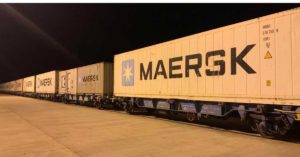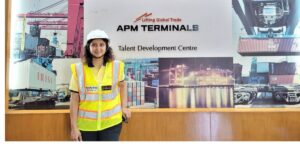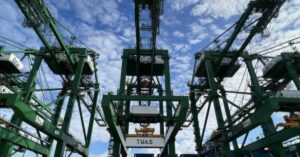“Our goal is to bring Artificial Intelligence to supply chains in a way that not only eliminates inefficiencies but also allows us to predict market behaviour, allowing customers to plan their supply chains and inventories in an efficient manner.”
– Vikash Agarwal, Managing Director, South Asia, A.P. Moller – Maersk
How has been the business for Maersk this year?
This year has been the year of normalisation after the last three years impacted by the pandemic. Despite that, on a global level, we have had a strong first half of the year, where we responded to sharp changes in market conditions prompted by destocking and a subdued growth environment. The volumes and revenue have been lower than the previous year, but our decisive actions on cost containment, together with our contract portfolio, have cushioned some of the effects of this market normalisation.
This has also been the year when we have started strengthening our solutions towards our customers in the space of integrated logistics. Talking specifically about the Indian market, we have continued expanding our warehousing footprint, we launched an industry-first e-commerce logistics solution, we strengthened our fleet in middle-mile distribution, including committing to more than 500 electric vehicles across multiple locations around the country; and all this was done in addition to adjusting and improving the ocean transportation solutions for our customers.
Another extremely important milestone for us in 2023 has been the introduction of our latest vessel that can run on green methanol. We are walking the talk with such actions, and I am proud to say that we have 24 more vessels in the order that will be on the water in the next year, helping us and our customers bring down emissions from ocean logistics.
The Indian government wants to invite more private sector participation in maritime infrastructure. What opportunities do you see here?
There is a clear and strong will from the Government to improve the state of logistics in the country. It has also been made very evident through the priorities listed in the National Logistics Policy, some of which include bringing down the cost of logistics, digitalising supply chains, improving multimodal connectivity and infrastructure, reducing the impact on the environment and so on.
We strongly believe that to achieve all these ambitions, it is important to make concerted efforts by the industry and Government together, including the private sector’s participation in maritime infrastructure. This way, it is possible for the private sector to bring diverse and multinational expertise to the table. Pooling in resources will also make solutions more accessible to a wider range of customers.
The global trade has been dull, and Indian exports have also been low during the first half of this year. What are your expectations for the next six months?
During our last financial results announcement at the end of Q2 (of the calendar year 2023), we anticipated the global container volume growth to be between -4% to -1%, which was lower than our initial estimate of it being between -2.5% to +1%. Our overall ocean transportation volumes are expected to be in line with the market behaviour.
From an Indian perspective, we are a little more optimistic for the coming months. The sentiment in India is improving with the Government focusing a lot on boosting local manufacturing and creating a favourable ecosystem for exports. While the demand from the Western markets has been soft so far, as we draw closer to the end of the year, restocking for the season might give exports out of India a gentle push. There are many multinational companies that have started strengthening their commitment to manufacturing in India and exporting from here. This will also start showing results in the coming months and years.
What are the initiatives taken by Maersk for emission reduction?
At Maersk, we have set ourselves to be Net Zero by 2040. Our decarbonisation ambition is also driven by what our customers want. More than two-thirds of our top 200 customers have their own targets to reduce emissions, and we are decarbonising our supply chains that would contribute to their targets, too.
We are taking several initiatives, starting with the in-fleeting of vessels that run on green methanol. Our first green fuel vessel is already on the water now, and we have 24 more in order that will gradually be added to our fleet. The next step for us is to look for and secure the green methanol required to fuel all these vessels in the future.
While the ocean transportation part is one of the largest contributors to emissions in our operations, we are also looking at reducing emissions from other landside sources. For example, all the investments that we are making in building and operating warehousing facilities include the element of using renewable energy for operations. In many cases, the material handling equipment used inside these facilities is battery-operated. We are adding a large number of electric vans to our middle-mile distribution network to reduce our carbon footprint.
In addition to these, we have also been running solutions that help our customers to move cargo by rail instead of road wherever possible, which also helps in bringing emissions down.
What are your short-term and long-term plans for the Indian market?
India is extremely important for us from both perspectives as a manufacturing as well as consumer market. This allows us to play a role in both ways – support the manufacturing sector by exporting their goods to global markets as well as distributing to local consumers and making global products available through imports to local consumers.
In the short term, we are working towards helping our customers navigate the new normalised global trade with our integrated logistics solutions. We are providing them with solutions that range from ocean transportation to air and landside transportation to warehousing and distribution. We are helping them take complexities out of their supply chains and bring down their cost of logistics. In the long term, we are focussing on putting technology to use in a way that can help our customers not only get better visibility of their supply chains but actually create recommendations and actions to navigate through unforeseen uncertainties. Our goal is to bring Artificial Intelligence to supply chains in a way that not only eliminates inefficiencies but also allows us to look into the future and predict market behaviour to allow our customers to plan their supply chains and inventories in a more efficient manner. Our ultimate long-term goal resonates strongly with our purpose to improve life for all by integrating the world.












